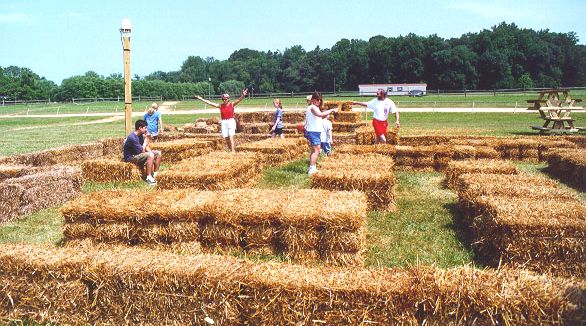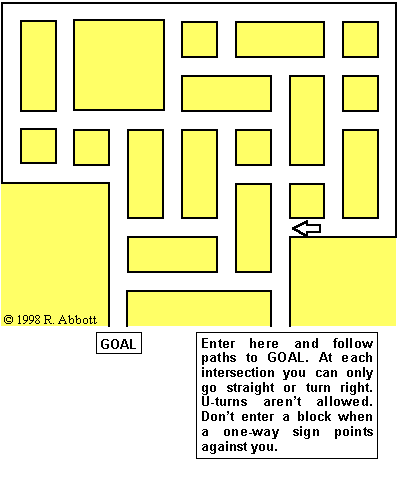Mazes-With-Rules You Can Walk Through
Walk-Through Mazes-With-Rules (1993 to 1998)
|
I really should come up with a shorter name than “walk-through mazes-with-rules.” These could also be called “walk-through puzzles.”
The idea for the mazes began in January 1993 when I was invited to participate in a puzzle exhibit at the Atlanta International Museum of Art and Design. The exhibit was dedicated to Martin Gardner, who wrote the Mathematical Games column in Scientific American. I was invited because Gardner had twice written about my game Eleusis and had printed two of my mazes.
I designed a maze for the museum that was a grid of paths to walk on. There were twelve intersections where the paths crossed. As you approached an intersection you saw a sign on your right with one or more arrows. The arrows told you what turns you could make at the intersection—for example you might see a sign with two arrows that indicate you can only go straight or turn left.
My maze was quite popular. The opening of the exhibit was attended by some of the most brilliant scientists and mathematicians in the country. (I’m really not exaggerating here. A lot of scientists are also interested in mazes and other forms of recreational mathematics.) Many of them were willing to spend up to an hour in the maze until they found the solution. But the day after the opening was also interesting. Groups of school children arrived at the museum, and they also enjoyed the maze. Some of the brighter kids followed the rules and stuck with the maze until they solved it. Others missed a sign here and there but thought they had solved the maze. And the youngest kids just ran around the maze and happily ignored the rules. And everybody had fun. This gave me the glimmer of an idea: Maybe I shouldn’t design mazes only for brilliant intellectuals. That idea sounds obvious now, but in the past I had tried to make my mazes as difficult as possible.
I wrote about my experiences at the Atlanta museum in the introduction to SuperMazes. One of the people who read my book was Don Frantz, whose American Maze Company had started the craze of large cornfield mazes that are popping up around the country. When Don built a cornfield maze, he liked to include three or four small mazes next to it—what he called “courtyard mazes.” These small mazes served various purposes, from expanding the maze experience to providing parents with a place to park the kids while they have lunch.
A digression about small mazes: Some amusement facilities have tried to add a small maze, thinking they can provide something interesting without devoting a lot of space. These small mazes never work. A conventional walk-through maze is great if it’s large enough. But if a conventional maze is shrunk to less than a certain size, it becomes trivial. It might be okay for toddlers, but no one else will have any interest in it. I’m not sure what the minimum size is, probably something around 100 x 100 feet. A maze-with-rules, however, can be very small and provide as much interest and complexity as a large walk-through maze. My maze at the Atlanta museum was only 15 x 15 feet.
Don Frantz got in touch with me and asked me to design some small mazes he could use next to his cornfield mazes. I provided a few designs, and he picked three of them to implement. Actually each maze was implemented six times, once at each of his cornfield maze sites during the summer of 1998. |
 The first site to open was on July 4, 1998 at Tanglewood Park just west of Winston-Salem, North Carolina. Here’s an aerial view, where you can just barely make out my small mazes. At the right is, of course, the cornfield maze. The circle at the top is a single-path labyrinth, based on ancient, sacred designs. There was a sign at the entrance to the labyrinth to explain that this is not a puzzle, instead you are meant to meditate as you follow the path to the center. Of course, everyone was running as fast as they could to see who could get to the center first.
The first site to open was on July 4, 1998 at Tanglewood Park just west of Winston-Salem, North Carolina. Here’s an aerial view, where you can just barely make out my small mazes. At the right is, of course, the cornfield maze. The circle at the top is a single-path labyrinth, based on ancient, sacred designs. There was a sign at the entrance to the labyrinth to explain that this is not a puzzle, instead you are meant to meditate as you follow the path to the center. Of course, everyone was running as fast as they could to see who could get to the center first.
Between the circular labyrinth and the blue tent are six small squares. That’s my Arrow Maze. To their right are 14 yellow circles, which is my Color Maze. And
to the left of the Arrow Maze is my No-Left-Turn Maze.
 In the foreground of this picture is the Arrow Maze. It’s similar to the maze I did for the Atlanta museum, but a little smaller. It probably was a little too difficult, but that didn’t seem to bother anybody. In the background is the Color Maze where you follow a yellow path, a red path, a white path, a yellow path, etc. It was moderately difficult and worked well.
In the foreground of this picture is the Arrow Maze. It’s similar to the maze I did for the Atlanta museum, but a little smaller. It probably was a little too difficult, but that didn’t seem to bother anybody. In the background is the Color Maze where you follow a yellow path, a red path, a white path, a yellow path, etc. It was moderately difficult and worked well.
|
And next is the best of the mazes, the No-Left-Turn Maze. I was trying to come up with the simplest set of rules I could think of, and this was it. At each intersection you can only go straight or turn right. Actually, that’s how a lot of beginning drivers operate. They plan a route through the city that lets them avoid any left turns. Notice that the maze was implemented simply by using hay bales. |

|
These mazes were a great success. The best compliments I got were from people who said they wanted to build similar mazes in their back yards. And the mazes worked for all ages. The very young were happy to wander around, especially among the hay bales, and no one even told them this was a maze. Meanwhile, their parents could also be in the maze attempting to discover the solution.
When I started working on these walk-through puzzles I had wanted to create a brilliant intellectual experience. The last thing I intended to do was create something that was “fun for the whole family.” But that’s exactly what I did create. |
 Here is a slightly improved diagram of the No-Left-Turn Maze. In the original I used two one-way signs. This was unfortunate because it spoiled the simplicity of the no-left-turn rule, and because a lot of people (for reasons I never understood) just ignored one of the signs. In this diagram I’ve cut it down to only one sign (shown as an arrow here). The sign is needed because if you take the first right turn, you’ll get stuck in a corner. Getting stuck is okay in a paper-and-paper maze, but I try to keep it from happening in these walk-through mazes.
Here is a slightly improved diagram of the No-Left-Turn Maze. In the original I used two one-way signs. This was unfortunate because it spoiled the simplicity of the no-left-turn rule, and because a lot of people (for reasons I never understood) just ignored one of the signs. In this diagram I’ve cut it down to only one sign (shown as an arrow here). The sign is needed because if you take the first right turn, you’ll get stuck in a corner. Getting stuck is okay in a paper-and-paper maze, but I try to keep it from happening in these walk-through mazes.
This maze is copyrighted, so it can’t be used in a public area without my permission. But if you want to build a maze in your back yard, feel free to use the design. And if you do build a maze (either with this design or your own design), send me a picture. My address is: P.O. Box 2596, Jupiter, FL 33468. If you have a digital picture, you might try sending it by
e-mail.
Recent Developments:
On Septmber 14, 1998, Andrew Plotkin wrote an insightful review about the corn maze in Paradise, Pennsylvania. He had this paragraph about my mazes:
Rules are Nifty: Outside the main corn-maze, there are several small
ones — not corn mazes; they’re made of hay bales and ribbons and such.
These use some wackier ideas, to make up for being able to see over the
walls. One has colored paths, and you have to follow paths in the order
yellow, red, blue. Another — surprisingly difficult — allows only
right turns, never left. (Sound like a simple rule? The consequences
take some time to work out, and then there’s a new shape in your head.
That’s what puzzles are for.)
Click here if you’d like to see the complete review. Or click here for Andrew Plotkin’s home page.
To pictures of my mazes during the summer of 1999. (It may take 5 minutes for all the pictures to load.)
Back to the home page.
|
 The first site to open was on July 4, 1998 at Tanglewood Park just west of Winston-
The first site to open was on July 4, 1998 at Tanglewood Park just west of Winston- In the foreground of this picture is the Arrow Maze. It’s similar to the maze I did for the Atlanta museum, but a little smaller. It probably was a little too difficult, but that didn’t seem to bother anybody. In the background is the Color Maze where you follow a yellow path, a red path, a white path, a yellow path, etc. It was moderately difficult and worked well.
In the foreground of this picture is the Arrow Maze. It’s similar to the maze I did for the Atlanta museum, but a little smaller. It probably was a little too difficult, but that didn’t seem to bother anybody. In the background is the Color Maze where you follow a yellow path, a red path, a white path, a yellow path, etc. It was moderately difficult and worked well.
 Here is a slightly improved diagram of the No-Left-
Here is a slightly improved diagram of the No-Left-